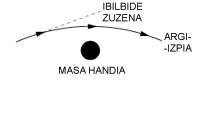Black holes: a little history (I)
In recent years black holes have become objects of great prestige. These stars, which have enough intensity so that the gravity zone does not come out of their influence even the light itself, allow nothing more to come out of their interior. Therefore, black holes are areas of space totally isolated from the rest of the Universe. They will continue to ingest the matter that might be in their environment, but by not being able to take anything out of their interior, in no case can you obtain information from it or know what happens there. These surprising peculiarities have become attractive and have transcended the realm of science, often appearing also in the cinematographic and literary fields.

If the name “black hole” was proposed twenty years ago and the modern theory of black holes is not many years old, the idea of massive astros that would not let out the light is much earlier. J. 1783 Cambridge professor Mitchel published a paper calculating the radius necessary for the escape velocity of a star of the same density as the Sun to be that of light. As is known, the escape speed is the necessary speed for one body to come out of the gravity of another. Imagine that we want to send a space to another planet.
If the velocity of space is less than the Earth's escape speed (11.2 km/s), space will ascend or lose energy (speed) and at a given moment its velocity will be zero. Then the movement deviates and falls back to Earth. If the speed exceeds 11.2 km/s, the energy of space will be sufficient to advance in interplanetary space and escape the influence of Earth.
As we said earlier, if the escape speed of an astro was higher than that of light (300,000 km/s), the light itself could not leave its gravity field either. The solar exhaust speed is 618 km/s. J. According to Mitchel's calculations, a Sun density star should have a radius five hundred times greater than that of the Sun so that light is also limited to its gravity field.
The British scientist was not the only one who noticed and addressed this problem. P. S. Laplace, in a work published in 1799, showed that the escape speed of a radio star R = 1,48.10-27 M (with the mass of the star M in kg) was the speed of light. These objects described by Laplace were called “dark bodies.”
It seems logical to think that these ideas were based on the corpus theory of light. In the following century, however, wave theory was imposed and from that point of view it was more difficult to understand how gravity could affect light. Perhaps that is why Laplace did not include conjectures about dark bodies in later publications.
References to dark bodies or black holes were not XX. Reexpose it until the beginning of the 20th century. The development of a complete and complete theory could not be done until Einstein published in 1915 the theory of general relativity and astrophysicists began to understand the last steps of the evolution of stars. It can be thought that considering the wave/fraction duplicity on which quantum mechanics is based, considering that light is formed by photons, the works of Mitchel and Laplace could again be useful.

However, these works have been made from the point of view of classical mechanics and do not take into account some particularities of light. We cannot compare the light generated by a star with space. The latter loses speed by increasing the height, but the speed of light is constant and does not decrease despite moving away from the star. One of the results of Einstein's theory is how gravity affects light.
According to the general theory of relativity, the path of light is the path and the shortest distance between two points. When space is empty, this pathway is direct, but when there is a body its gravity field deforms the surrounding space, tilting also the path of light. The first figure shows an example of this effect: the ray of light that goes through space becomes when it passes through a massive body.
C. 1916 Schwarzschild used Einstein's theory to analyze the situation of space around a large mass point, to theoretically define the black hole without rotation. The German scientist also calculated the radius of the black hole obtaining the same value as Laplace. The spherical surface defined by the radius is called the limit of events and everything inside is a black hole.
Therefore, it is not possible to get out of it. As for the path of light, the different situations described in Figure 2 will help us understand the problem. If we consider the case of a simple first star, (a), the gravity field will not be very strong and the light will escape following the correct path. If we consider that the star contracts, (b), the same mass accumulates in a smaller volume and the rays come out, but deviating through the straight path. In short (c), the rays will bend completely, returning to the surface that have been reproduced (in the case of the black hole).
However, black holes could not say whether or not they existed in the Universe as defined mathematically by Mitchel, Laplace or Schwarzschill. Then the work of astrophysics was the one that channeled the problem, but the contributions of astrophysicists will be discussed in the following issue.
EPHEMERIS SUN: On February 18 enters Pisces in 15h 35m (UT).
PLANETS
|





